Getting started with Mouf's user interface
In this document, we will show how to use Mouf DI framework to create and fetch instances.
You can use Mouf to create any kind of instances from any classes (mostly services and components as you probably read in the previous chapter).
In order to prove Mouf is truly generic, we will take a completely abstract sample that is not related to web development. Our sample will be about role-playing games!
Finished the video? In a hurry?
Learn what you can do with Mouf on the Skills chart >
Keep learning about dependency injection and the supported injection techniques >
Get started with the full-stack MVC framework >
The playground
Here is our test class diagram.
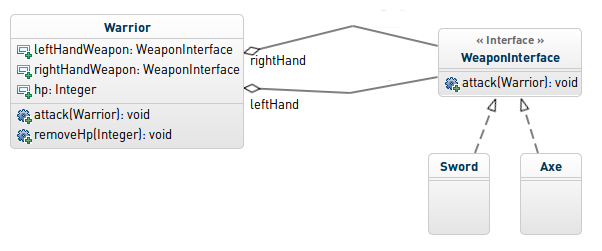
In this application, we will have 2 warriors (class Warrior) that will fight.
Each warrior has 2 weapons (one in the left hand and one in the right hand). A weapon
is a object implementing the WeaponInterface. We have 2 concrete implementations: Axe and Sword.
Using Mouf, we will create 2 instances of Warrior: a $hero and an $enemy.
We will use Mouf to inject weapons into this instances.
Prerequisite
Before creating the instances, we must create the classes we want to instantiate.
If you are used to create classes that respect the PSR-0 or PSR-4 naming conventions, just have a quick look at our test classes and jump to the next session.
- Class
Warrior - Interface
WeaponInterface - Classes
AxeandSword
You can also install a test project containing the sample classes very easily using Git and Composer:
git clone https://github.com/thecodingmachine/samples.tutorial.git
php composer.phar install
Creating the instances
When you log into Mouf, you can see an Instances menu. From this menu we will manage our instances.
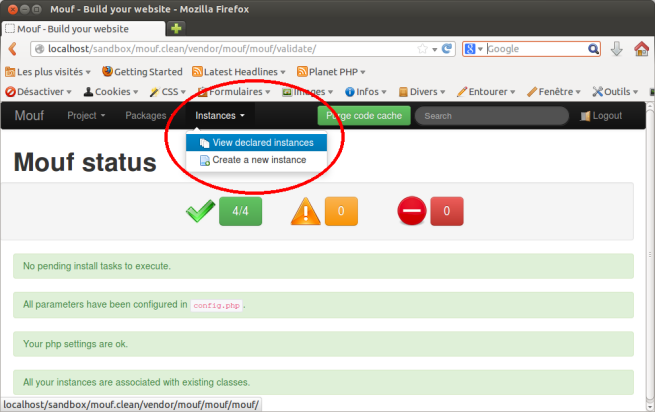
You can:
- View all the declared instances
- Create a new instance
Since we are just getting started, we have no instances defined so far. We will therefore create a new instance.
Let's start by creating the "hero" instance.
Click on the Create a new instance menu link.
On the new instance page that appears, you must give a name to your instance, and also specify the type of the class to instanciate. A search box with a filter will help you to find your class quickly.

Configuring the instances
Once the instance is created, we arrive on the instance configuration page:

As you can see, Mouf has been able to detect the constructor arguments.
class Warrior {
...
public function __construct(
WeaponInterface $leftHandWeapon,
WeaponInterface $rightHandWeapon,
$hp
) {
$this->leftHandWeapon = $leftHandWeapon;
$this->rightHandWeapon = $rightHandWeapon;
$this->hp = $hp;
}
...
}
Actually, Mouf can detect 3 types of properties that can be "injected" (it means "configured"):
- Constructor arguments: any argument in a constructor can be configured in Mouf (actually, any argument that is not compulsory MUST be configured in Mouf, otherwise, Mouf won't be able to instantiate the object)
- Public properties: any public property of a class can be edited using Mouf
- Setters: any setter (a function with one parameter starting with the 3 letters "set") can be called by Mouf.
You can learn more about those 3 types of injection in the "Supported injection techniques" page.
In this sample, we are going to create a Axe and a Sword instance and give it to our hero.
To do this, we just have to press the orange button next to "leftHandWeapon".
Here is what happens:
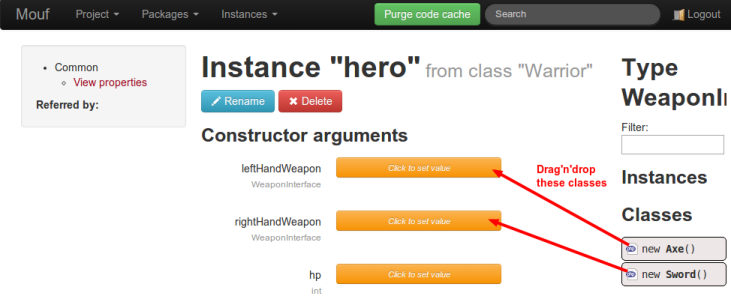
First of all, you can see that Mouf is displaying, in the right column, a way to create new Axe and
Swordinstances.
This is because both classes implement the WeaponInterface and because the leftHandWeapon constructor's parameter
must be a WeaponInterface.
Mouf correctly manages to infer the type of each argument of the constructor. Check the documentation about type inference if you want to learn more about the way Mouf does this..
There are many supported types in Mouf (classes, primitive types, arrays, ...). To learn more, check the supported types document.
Now, we want to create a new Axe instance and feed it to our hero's left hand and
a new Sword instance into our hero's right hand.
To do this, we can simply drag'n'drop the new Axe() icon into the "leftHandWeapon" constructor's parameter
of the "hero" instance. We will also set the hit points of our hero using
the last parameter of the constructor.
Once the drag'n'drop is completed, we see this:
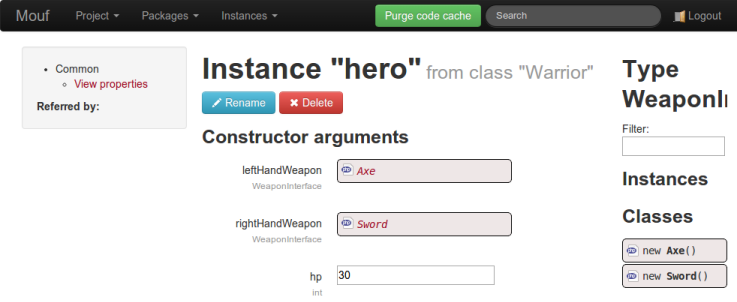
A click on the anonymous "Sword" instance we just created will land us on the sword instance page.
Finally, we can also fill the hp parameter (a primitive type) directly in the UI.
For the purpose of this tutorial, we will also create a second Warrior instance and call it enemy.
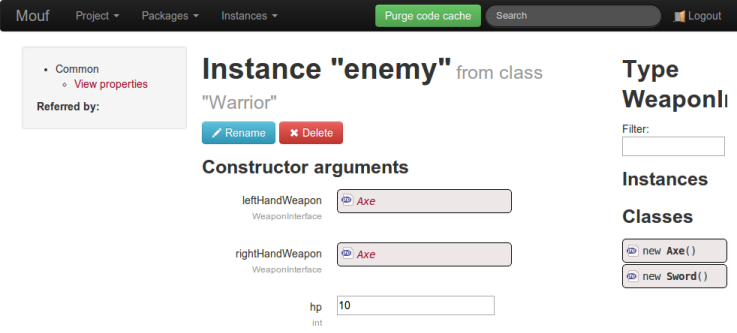
Using the instances
We have now successfully created our instances, but we don't know yet how to use them.
When you configure your instances, Mouf creates a Mouf class. This class contains functions
that will allow you to access your instances, through static getters. We have 2 instances: hero
and enemy. We can access those through the Mouf::getHero() and Mouf::getEnemy() method.
Before calling the Mouf class, you have to be sure that Mouf DI component is initialized. This
is simply done by including the mouf/Mouf.php file.
So to have a fight between our characters, we would simply write:
fight.php
require 'mouf/Mouf.php';
$hero = Mouf::getHero();
$enemy = Mouf::getEnemy();
$hero->attack($enemy);
// Will print "I'm dead!"
Container-interop compatibility
Mouf is fully compatible with the container-interop project. Actually, Mouf is one of the project that started container-interop.
You can access the instance by its name, using the MoufManager class. For instance:
require_once 'mouf/Mouf.php';
// The $moufManager object represents the DI container
$moufManager = MoufManager::getMoufManager();
if ($moufManager->has('hero')) {
$hero = $moufManager->get('hero');
}
Using the Mouf class and the MoufManager class
Mouf class or the
MoufManager class. Indeed, if you do so, you are using the dependency
injection container as a service locator. The service locator pattern
is usually considered harmful, because your code depends on the service locator.
Instead, you should rely on an MVC framework that will use the DI container itself.
This way, you get a controller with all instances directly injected.As a rule of thumb, if your code is using a nice MVC framework (like Splash) and
if your code is calling the Mouf class or the MoufManager class, you are probably doing
something wrong and you might want to reconsider what you are doing.
If you want to read more about why the service locator pattern is an anti-pattern, check this article.
Where are the instances stored?
So far, we used Mouf as a black box. But there is no magic, Mouf has to store the instances we defined somewhere! Actually, all instances are stored in the mouf/MoufComponents.php file.
Usually, you will never have a look at that file. It is quite long and you never edit it manually, instead you use Mouf UI.
If you are working in a team however, with a version control system, if you are creating an instance and one of your colleagues is creating an instance, you might get conflicts in that file.
Instances are all stored in one big array. Each key is an instance name and the value is a descriptor of the instance. It is usually not that difficult to resolve conflicts, since the array is self-descriptive.
Here is the portion of the MoufComponents.php file relative to the hero instance
we just created:
$moufManager->addComponentInstances(array (
...
'hero' =>
array (
'class' => 'Mouf\\Sample\\Warrior',
'external' => false,
'weak' => false,
'constructor' =>
array (
0 =>
array (
'value' => '__anonymous__746802_1400434107610',
'parametertype' => 'object',
'type' => 'string',
'metadata' =>
array (
),
),
1 =>
array (
'value' => '__anonymous__504284_1400434110615',
'parametertype' => 'object',
'type' => 'string',
'metadata' =>
array (
),
),
2 =>
array (
'value' => '30',
'parametertype' => 'primitive',
'type' => 'string',
'metadata' =>
array (
),
),
),
),
...
));
Going further
Want to go further?
Learn more about the supported injection techniques >
Learn more about the types supported by Mouf >
Learn how to use annotations to make dependency injection even easier >
Found a typo? Something is wrong in this documentation? Just fork and edit it!